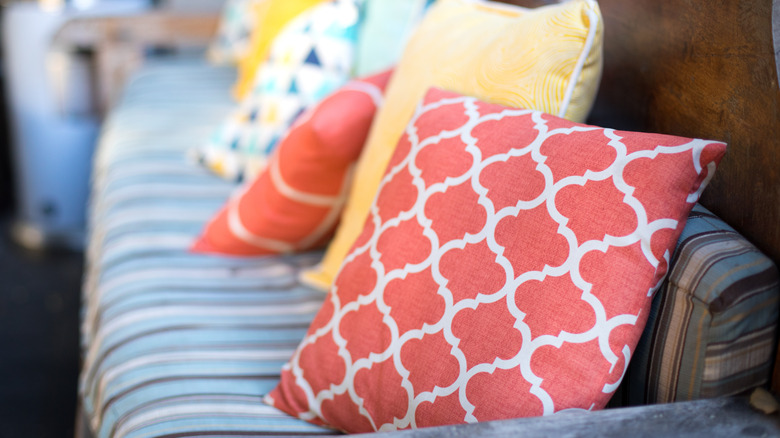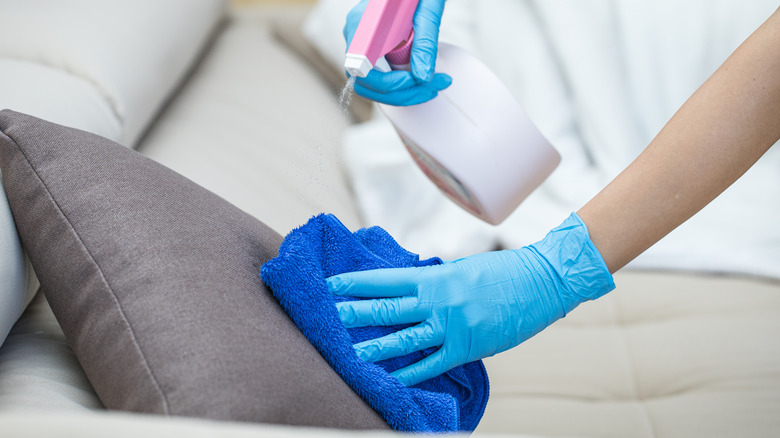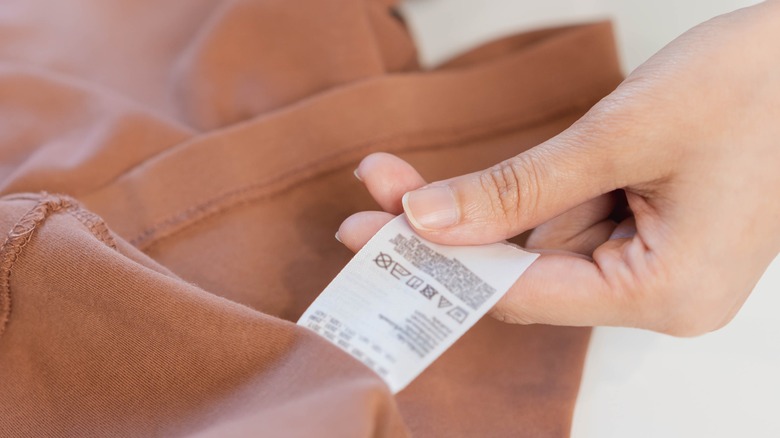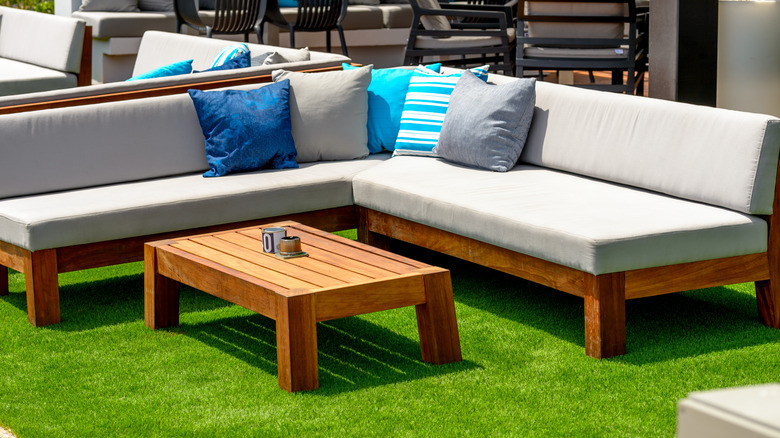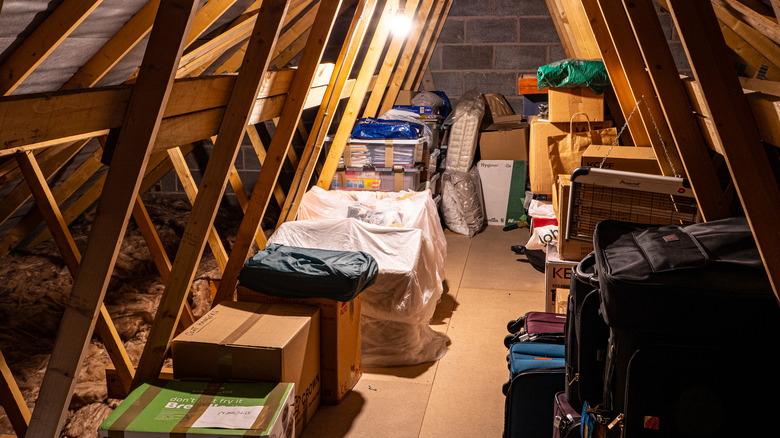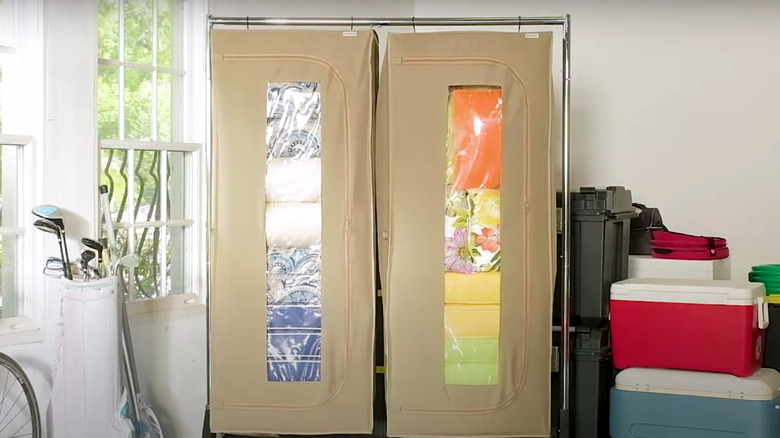An Expert Tells Us How To Make Sure Your Outdoor Furniture Cushions Are Ready For Winter Storage
With the colder months waiting just around the corner, it's time to reluctantly say goodbye to your cozy patio furniture until next season. Although outdoor chairs, tables, and umbrellas can be simply covered with a tarp and left in a dry area throughout the winter, the outdoor cushions require a little added protection. Although these types of cushions are made from durable materials so that they're able to resist damage from the sun, wind, and rain, they're not necessarily designed to be covered in frosty snow for extended periods of time.
Popular outdoor cushion materials such as cotton or canvas may be less expensive, but because they're not resistant to moisture, they could be prone to collecting mold and mildew. However, cushions designed using Sunbrella fabrics — although a little pricier than other fabrics, according to Patio Productions — have the added bonus of being waterproof, fade-resistant, and able to ward off mold and mildew. This can be especially handy when storing them away for the winter months.
For advice regarding best practices for storage, we got the inside scoop from an expert. In an exclusive interview with House Digest, the co-founder and editor at Grow Your Yard, Simon Barker, says, "If you have outdoor cushions that you don't plan on using during those cold winter nights, you'll need to take some simple steps to prepare them for storage."
Ensure they're spotless
Once you've come to terms with the end of summer and need to start tucking away all the patio furnishings, there are a few things to consider. "The first step is to make sure your outdoor cushions are clean," expert Simon Barker tells us. "Even if they don't look dirty, it's important to get rid of any dirt, pollen, or other debris that could lead to mildew or mold growth during storage." To get the best results, it's crucial to fully clean your cushions before putting them away.
When hand-washing outdoor furniture cushions, first shake them off, then lightly spray them with your garden hose. Make certain not to soak the material through, just dampen the surface. Mix together a cleaning solution containing a few drops of liquid dish soap and about a half-cup of Borax in a bucket of water, advises HGTV. The solution can then be scrubbed into the cushion material using a bristled cleaning brush until you feel it's at its cleanest. Spray again with your hose to rinse off the soapy residue. Then squeeze out the excess water and leave the cushions to dry completely in the sun. Although the process may be a little time-consuming depending on how many cushions you have, Barker insists that "You'll want to get them out of storage at the first sign of sun next spring, so make sure you put in the time now."
Always read the label
If you don't have time to hand wash your cushions and would rather pop them in the washer before storing them for the winter, then you may want to slow down and read the fine print first. "Different materials on your outdoor cushions will have different washing instructions, some you'll be able to hose down in the garden, and others you'll need to put on a delicate wash," says Simon Barker. "Make sure you read the label before you start cleaning so you don't damage them." Although running these items through your regular washing machine may seem like the quickest option, you wouldn't want to sacrifice the quality of the cushions in the interest of saving time and energy.
Also, when it comes to pieces of patio furniture that have larger seat cushions, you may find that these could become cumbersome in a household washer. Overloading your washer with bulky items could cause unnecessary damage to your machine as most washers can only hold a maximum amount of around 21 pounds of material, according to Tide. Instead, gentle hand washing could be all it takes to rid your cushions of the previous summer's wear, or as Barker suggests, "If in doubt, always err on the side of caution and take them to a professional cleaner." A professional service will have the tools necessary to take care of the job while ensuring that the cushions are free from moisture once the process is finished.
Let them dry completely
When putting away your outdoor patio cushions in wait for the next sunny season, there's one crucial step that should not be overlooked. "Once you've given your outdoor cushions a good clean, it's important to let them dry completely before storing them away," expert Simon Barker cautions. "If they're even slightly damp, they could develop mold or mildew over the winter months." If you live in an area with high humidity or rain throughout the spring and summer seasons, this could, unfortunately, mean that your patio cushions are susceptible to this fungal problem.
You should make certain the cushions stay dry whether you're using them or not. To keep them free of moisture "leave them out in the sun to dry," Barker suggests. "Or, if it's not sunny," he adds, "put them in a well-ventilated room until they're completely dry." That way they won't constantly collect water throughout the evenings and mornings. If your cushions already have mold and mildew on them, there's an easy solution to get rid of the problem. Just take a spray bottle with undiluted white vinegar and spritz the surface of the cushion fully, according to The Backyard Pros. Let it sit for up to an hour then rinse it with a damp sponge and allow it to dry. The vinegar will kill the mold and help to release the stains as well.
Find a dry storage area
Finally, you have all of your outdoor furniture cushions set aside and ready to be placed away for the winter, but where are the ideal spots so that they stay safe from damage? "Once your outdoor cushions are clean and dry, it's time to find a suitable storage location," Simon Barker tells us. "You'll want to find a spot that's dry, dark, and cool, as these are the ideal conditions for storing cushions (and other fabrics)." That means that unless your outdoor shed is sealed and insulated so that no moisture can make its way in, it might not make for the best storage area for your cushions.
Instead, you could opt for a locale either inside your home or attached to it. Per Barker, "A garage or shed is often the best option, but if you don't have either of these, try to find a spot in your basement or attic that fits the bill." Although every home is different, as long as the area does not have a large amount of moisture build-up and remains out of the way of your regular use, then it should be suitable for storing patio cushions for the winter.
Use a cover or bag
Although preserving the cushions to your patio furniture in a room with the ideal conditions can be enough to keep them safe, there is another way to ensure they won't be ruined. "To further protect your outdoor cushions during storage, it's a good idea to use a cover or bag," Simon Barker recommends. "This will help to keep out any dust, dirt, or pests that could damage them." Cushion storage bags are generally made from a durable polyester material and can be easily purchased online at an affordable price. The polyester fabric is perfect for the job as it is able to repel water, and resist heat, mildew, and chemicals, explains Silver Bobbin. These flexible bags can hold many cushions in one convenient spot with handles that make moving them a breeze. Barker also notes that when choosing the ideal storage bag you want to "make sure it's breathable so that your cushions don't get too hot or moist during the winter months."
As far as organization goes, getting a cushion bag can also ensure that no pieces go astray. It would be frustrating to see the first signs of spring and get excited to start laying out your patio furniture, only to be left wondering where all of your cushions are. With a handy bag, you can keep everything together in one spot and make it easier for when patio season starts again.
